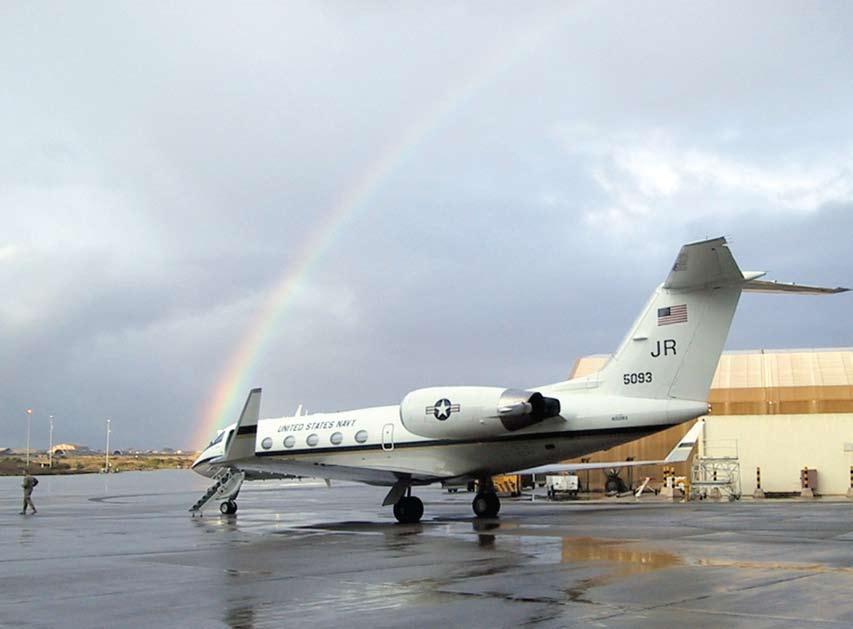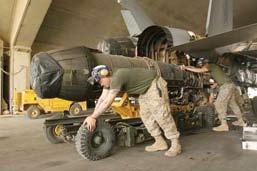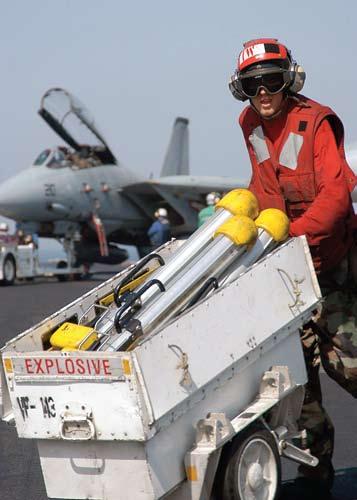
8 minute read
How To Lose Your Quals
from Spring 2008
How To Lose Your
By AME1(AW) John Shorb
Advertisement
Ihad 32 days left until I checked out of the command and headed from Washington D.C. to Point Mugu, Calif. I was the only qualified QAR working, and all of the shops needed me to CDI their MAFs. But I was seasoned to this work tempo, and being an AME1 and full-systems QAR meant I practically could do it all. I had been working in QA longer than anyone else in the command and had seen it all, or so I thought.
Our first priority was to remove and replace three of five, M-193 fire-extinguishing CADs for high time. As the QA/SO for the task, I was ready to go. Our ordnance board just had qualified two third class petty officers as ordnance handlers, and this was to be their first “live” ordnance evolution. We prepared for our task, placed the MAFs in work, set HERO condition, and roped off the aircraft. We carried our tools and parts out to the aircraft and set up to work.
We removed the right engine and APU fire bottles. The right bottle has two CADs, and the APU has only one. The left engine CADs had been replaced three months before, so they were good and didn’t need to be removed. Once the bottles were out, we removed the old CADs, installed the new ones, and prepared to do our firing-circuitry test.
We decided to take a break. I made a head call and checked with the other shops to check progress on the gripes with our other aircraft. When we came back, we were ready to hook up electrical power to the aircraft and do the test.
The first note in the book about the test says, “This test will discharge the fire bottles.” No kidding,
so we removed them. The second step of the test says to remove the positive leads of all the CADs. Well, if the bottles are out, the leads are off. We then checked the voltage at the leads to make sure there was 28 volts to fire the CADs. I asked one of the workers to go to the cockpit and pull-and-turn the fire handles, while I stayed with the second maintainer in the tail to check the voltage. We hooked up to the right bottle leads and turned the right-hand fire handle to shot No. 1: 28 volts, checks good. We turned the right-hand fire handle to shot No. 2: BOOM!! 28 volts went to the left bottle, the CAD exploded and sent the extinguishing agent into the right engine nacelle. The fireextinguishing system worked as advertised.
My first thought was that I had killed the worker in the tail compartment reading the volts. I asked him if he was OK, and he said, “Yeah, just a little hard of hearing after that explosion that went off.” As we climbed out of the tail compartment and could see the white smoke coming out of the engine nacelle, it hit me…I was an idiot.
The second maintainer came out of the cockpit and asked if we were all OK? We answered yes, but we were just a little shaken up. The CAD went off less than three feet from us. We gathered all our tools, locked up everything, and went to maintenance to give them the news.
Maintenance control’s first reaction was, “Yeah right, so you’re done? Can we secure from HERO condition and get some work done?” To convince them, it took about 10 minutes of discussion and a visit to the aircraft. Why didn’t they believe me? I guess because I’m the ordnance program manager, and guys like me don’t make mistakes…until now.
In my case, I lost my ordnance certification, which in turn makes me ineligible as a full-system QAR for workcenter 13B. As an ordnance board member and program manager, I also am required to be ordnancecertified, so there went those positions. But none of that matters to me at the moment. I almost had killed a shipmate. That is the part that I cannot fully grasp. He has a wife and baby, and a mother and father could have lost a son. Speaking of family, my wife just had our first child 17 days ago. I could have widowed my wife and could have left a newborn baby without a father.
Naval aviation can be dangerous, but it’s not until something like this happens that you realize just how dangerous. No one was hurt, and no damage was done. This was my freebie, but I’ll have to work at my new command to back my quals. Most people will forget this event ever happened, but I will live with the memory for the rest of my life.
Petty Officer Shorb worked in the AME shop at VR-48 when he wrote this story.
Jeff Hobrath is a retired PR chief who has volunteered to help MECH with this comic series. We take some liberty with the Rats for the price of a message through humor. For more info on Jeff Hobrath, simply do a search for Jeff Hobrath on the internet.


By Jeff Hobrath
In August 2006, the Joint Aeronautical Logistics Commanders (JALC) sponsored the Navy, Marine Corps, Army, Air Force, Coast Guard, and Defense Contract Management Agency (DCMA) to develop a Joint Deficiency Reporting System (JDRS), based on NAVAIR’s NAMDRP program.
JDRS provides a common, seamless solution to report, track and resolve technical deficiencies that the fleet identify across the Aeronautical Enterprise. JDRS is a cross-service, webenabled, automated tracking system designed to initiate, process and track deficiency reports from the fleet through the full investigation process.


NAVAIR’s NAMDRP/JDRS development team consists of senior programmers, functional requirement experts, application testers, and various program-support personnel at NAS Patuxent River, Md.
Working alongside the JDRS development team are support teams from the Navy, Marine Corps, Army, Air Force, Coast Guard and DCMA.
Currently, NAMDRP serves more than 9,400 users, averaging 225 transactions per day and 4.5 million hits per year. With the addition of Air Force, Army, Coast Guard, DCMA, and other agencies, JDRS will support more than 20,000 users processing 50,000-plus deficiency reports annually, making it one of the most robust joint-service web applications ever developed.
The benefits of JDRS are significant, and they include: • Improved quality of material and readiness • Enhanced visibility of deficiency reports across all services • Increased visibility of critical safety items throughout the aeronautical enterprise • Reduced total ownership cost and cycle time • Partnered efforts between government and industry • Improved exhibit inventory management and management metrics • Automated routing of deficiency reports and ease of use
The various JDRS deficiency reports includes: product quality deficiency reports (PQDRs); engineering investigations (EIs); material deficiency reports(MDRs); acceptance inspection deficiency reports (AIDRs); and hazardous material reports (HMRs). Technical publication deficiency reports (TPDRs) will be added in the near future.
JDRS is scheduled to launch in spring 2008.
Mr. Hobrath works for NAWCAD, Code 7.2.2, NAMDRP/JDRS Program Office, NAS Patuxent River, Md. Flight, Flight-Related, and Ground Class A and B Mishaps 12/17/2007 to 02/26/2008
Class A Mishaps Date Type Aircraft Command
01/07/2008 FA-18E VFA-105 Two Hornets were lost at sea after a mid-air collision. Aircrew survived. 01/16/2008 MH-53E HM-15 Helicopter struck terrain during night flight. Injury unknown. 01/21/2008 EA-6B VAQ-136 Prowler had an engine-bay fire while undergoing a high-power turn. 02/12/2008 EA-6B VAQ-136 Aircraft lost over water during large-force exercise. Aircrew recovered. 02/13/2008 AV-8B HMM-365 During RTB pilot unsucessfully attempted air start. Pilot ejected safely.
Class B Mishaps Date Type Aircraft Command
01/17/2008 MH-60S HSC-3 Helicopter experienced hard landing at NOLF. 01/17/2008 SH-60B No. 2 engine fire on ground. HSL-40
01/19/2008 AH-1W HMT-303 Helicopter rolled after contacting ground during simulated fixedpitch. 01/30/2008 EA-6B VAQ-129 During night CQ, underside of rudder struck landing area following waveoff. 2/04/2008 FA-18D VFA-125 Aircraft engines fodded during in-flight refueling. 02/07/2008 FA-18C VFA-83 Left engine FOD from bird strike in landing pattern. No injury. 02/11/2008 FA-18F COMSTRKFIGHTWINGPAC Service member injured by spoiler during ground maintenance turn. 02/11/2008 KC-130T VMGR-452 Aircraft damaged when immersed in fire-suppression foam. 02/20/2008 P-3C VP-10 Starboard wingtip area collided with crash rescue vehicle. No injuries.
Printed as a supplement to Mech from Naval Safety Center Data Cdr. Ed Hobbs For questions or comments, call Dan Steber (757) 444-3520 Ext. 7247 (DSN 564)
Maintainers in the Trenches
A maintenance crew works on an FA-18C Hornet assigned to the Stingers of Strike Fighter Squadron (VFA-113), during flight operations aboard Nimitz-Class aircraft carrier USS Ronald Reagan (CVN-76). Navy photo by MC2 John Curtis



Cpls. William Thornton (left) and Jeffers Page, along with other Marines, roll an engine out from an F/A-18 Hornet at Al Asad, Iraq. The Marines are with the phase maintenance section of Marine All-Weather Fighter Attack Squadron 533, Marine Aircraft Group 16 (Reinforced), 3rd Marine Wing. Photo by Cpl. Jonathan Teslevich
AMAN Miranda Long makes repairs to a P-3C Orion engine housing at Fleet Readiness Center (FRC) Northwest aboard Naval Air Station Whidbey Island (NASWI). Navy photo by MC2 Jon Rasmussen AO3 Joseph Little moves Bols chaff loaders across the flight deck aboard USS George Washington (CVN-73). Navy photo by PHAN Jessica Davis






